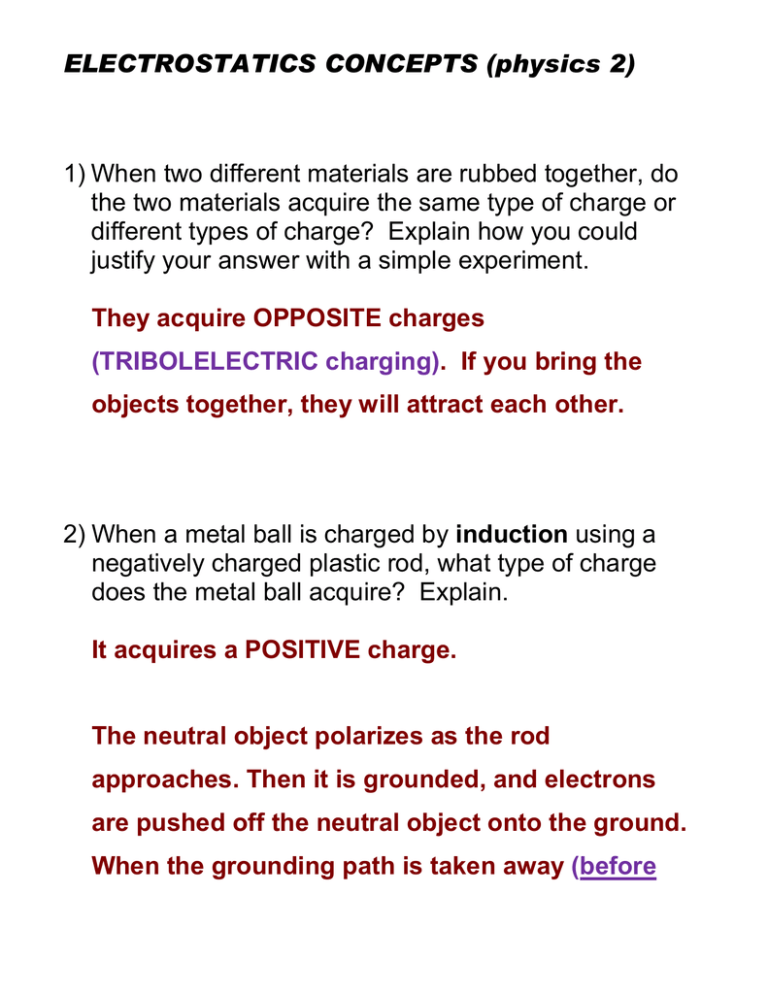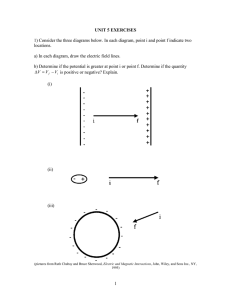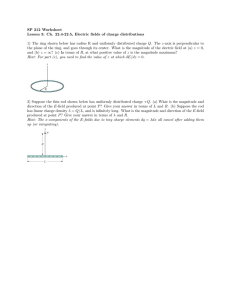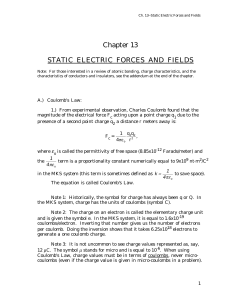ELECTROSTATICS CONCEPTS (physics 2) #1
advertisement

ELECTROSTATICS CONCEPTS (physics 2) 1) When two different materials are rubbed together, do the two materials acquire the same type of charge or different types of charge? Explain how you could justify your answer with a simple experiment. They acquire OPPOSITE charges (TRIBOLELECTRIC charging). If you bring the objects together, they will attract each other. 2) When a metal ball is charged by induction using a negatively charged plastic rod, what type of charge does the metal ball acquire? Explain. It acquires a POSITIVE charge. The neutral object polarizes as the rod approaches. Then it is grounded, and electrons are pushed off the neutral object onto the ground. When the grounding path is taken away (before removing the charged object), the once-neutral object has lost electrons. 3) If, when charging by induction, you remove the charged rod from the vicinity of the metal ball before moving your finger from the ball, what will happen? Will the ball end up being charged? Explain. The electrons will redistribute themselves and the ball will end up being neutral (it will not have lost nor gained any electrons in the process). 4) Can pith balls be initially attracted to a charged rod and then later repelled by the same rod, even though they have not touched any other charged object? Explain. If the pith balls contact the rod during the initial attraction – due to polarization of pith balls – they may obtain the same charge as the rod due to CONDUCTION. They will then be repelled. 5) If the distance between two small charged objects is doubled, will the electrostatic force that one object exerts on the other be cut in half? Explain. No; since F 1 and r2 = 2 r1 , then F2 = ¼ F1 . 2 r 6) If two charges are both doubled in magnitude without changing the distance between them, will the force that one charge exerts on the other also be doubled? Explain. No; since F q and both q1 and q2 are doubled, then F2 = 4 F1 . 7) If a positive charge is moved toward a negative charge, does the potential energy of the positive charge increase or decrease? Explain. It decreases. It is being moved closer to its “endpoint”. (Same as moving a mass closer to the ground – it loses PEg.) 8) If a negative charge is moved in the same direction as the electric field lines in some region of space, does the potential energy of the negative charge increase or decrease? It increases. It is moving closer to a repulsive area – it is experiencing force acting opposite the direction it is moving. (The E-field direction is the direction of the force on a positive charge; a negative charge experiences the opposite force.) 9) Is electric potential the same thing as electric potential energy? Explain. Electric potential is defined as the electric PE e potential energy per unit charge. V q Electric potential measures the “energy-giving ability” of a location in an electric field and does not depend upon the charge that is placed at that spot. 10) A positive charge is placed in an electric field. It is then moved in a direction opposite that of the electric field direction. Did it move to a region of higher or lower potential? Since it would be experiencing a force opposite the direction it is moving, it would be moving away from its endpoint. Therefore, it would be gaining PEe and would be moving to a HIGHER potential region. 11) What is a capacitor made of? What would you do with it? How does it work? Two parallel conductive (metal) plates with an insulator in between. It is used to store electric energy by storing charge in the E-field between the plates. Electrons are placed onto one plate and taken off the other. The excess electrons move into the dielectric and are stored there. When the plates are connected by a conductive path, the electrons move from the negative plate to the positive plate, releasing their electrical energy. 12) During an electrical storm, a parked car becomes charged negatively by a passing thundercloud. Describe the location of the excess electrons gained by the car. (Where on the car would you find them?) Since the frame of the car is a conductive shell, the excess charge would only be found on the outside surface of that shell, with greatest density at sharp corners and edges. No charge would be on the inside of the frame shell. 13) The diagram below shows an electric field, illustrated by E-field lines. Is this an example of a uniform electric field? How can you tell? No; the E-field intensity decreases from left to right. The lines spread out, becoming less dense. 14) Two positive charges, each of magnitude 3.0 x 10-6 C, are located a distance of 10.0 cm from each other. What is the magnitude of the force exerted upon each charge? q1q2 k 2 r F 9 N m2 9.0 x 10 F C2 (3.0 x 10-6 C)( (0.100 8.1 N 15) A uniform electric field is directed upwards and has a magnitude of 2.5 N/C. Calculate the force on a -5.0 x 10-3 C charge placed in this field. E F q F Eq (2.5 N C)(5.0 x 10 -3 C) F 0.0125 N, down 0 16) What is the magnitude and direction of the electric field at a point 2.00 m away from a +0.0250 C charge? E q k 2 r E 9.0 x 10 9 N m2 5.63 x 10 7 N C C2 0.0250 C (2.00 m) 2 5.6 , away from the ch 17) Suppose that the top plate of a parallel-plate capacitor has an electric potential of 0.0 V and the bottom plate has a potential of 450 V. The plates are 2.0 cm apart. What is the magnitude of the electric field between the plates? V E V V2 V1 Ed 450 V - 0.0 V 23,0



